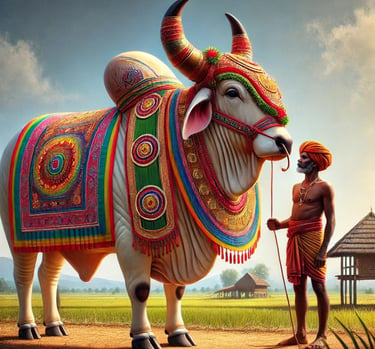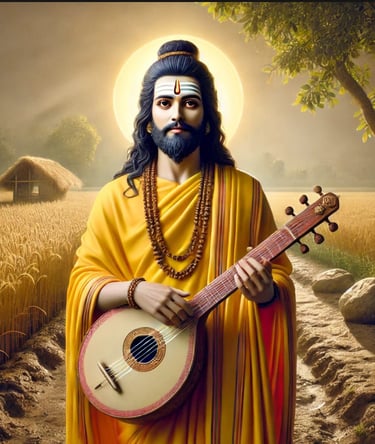Konuma: The Sacred Ritual of Sankranti’s Harvest Blessing
Discover the timeless traditions that celebrate gratitude, interdependence, and the blessings of the harvest. Let’s reconnect with the essence of life and the rhythms that sustain it.
CULTUROSCOPE
Sankranti, a festival that unites the vast expanse of India, marks the celestial transition of the Sun from Sagittarius to Capricorn. Known by a variety of names across the country—Makar Sankranti in the north, Pongal in Tamil Nadu, Lohri in Punjab, and Uttarayan in Gujarat—it is a celebration that transcends cultural and geographical boundaries. At its heart, it is a festival that honours the Sun, a divine giver of light, warmth, and vitality, and it signifies the eternal cycle of nature’s rhythms and renewal. This is when the earth, once dormant under winter's cold embrace, stirs with new life. The sun’s movement represents a shift—from darkness to light, from winter to harvest, from stagnation to energy. It marks the reawakening of the world, both in the fields and in the human spirit.
From the air filled with the sound of kites soaring high to the warmth of bonfires crackling against the night, Sankranti is an invitation to celebrate the abundant harvest that nature has gifted. Across India, the celebrations bring communities together in a collective joy of gratitude and hope. The vibrant colours, the sweet scent of tilgul (sesame sweets), the laughter of families, and the rhythmic dances echo not just the end of one season but the continuity of life itself.
In the rural heartlands of India, where agriculture is the lifeblood of the people, Sankranti also represents the cosmic dance between the Sun and Earth, between human labour and divine blessing. It is a time to express deep gratitude to the forces of nature and to acknowledge the interdependence between humans, animals, and the environment. While the entire nation celebrates with a sense of shared joy, the states of Telangana and Andhra Pradesh bring forth a unique, soul-stirring ritualistic experience that speaks to the sacred bond between humankind and nature—this is where the story of Kanuma unfolds.
Kanuma: A Celebration of Life and Livestock
Following the transformative celebrations of Bhogi, which ushers in new beginnings, and Makara Sankranti, which honours the sun’s transition and the abundance of the harvest, the festival continues its journey with Kanuma. The third day of the Sankranti festival, Kanuma, is not merely a celebration of the harvest—it is a profound ritual, honouring the animals that sustain human life. At the heart of this tribute is the Gongireddu, the sacred bull, adorned with garlands, bells, and vibrant fabrics. The bull is more than a beast of burden; it is a symbol of strength, vitality, and divine presence, essential to the cycles of nature and agriculture.
During the celebrations, the Basavanna, the handler of the Gongireddu, smears kumkum (vermillion) on the bull's forehead. This simple yet significant act symbolizes both protection and sanctification, marking the animal as a divine companion in the shared rhythm of life. It acknowledges the animal’s essential role and elevates it as a living manifestation of the divine energy that sustains all.
The Basavanna’s relationship with the bull goes beyond mere caretaking. He is a spiritual guardian, embodying the humility and strength of Lord Shiva's Nandi. His role transcends that of a handler—he is a protector, a keeper of the sacred bond between man, animal, and land.
Kanuma also reflects the enduring memory of Lord Krishna's victory over Indra, a pivotal moment in Hindu mythology. When the villagers of Vrindavan, led by Krishna, defied Indra's demand for a sacrifice, the wrathful god unleashed a torrential downpour. In response, Krishna, as Govinda, the protector of cows, lifted Govardhan Hill with his little finger, offering shelter to the cattle and villagers. This act, symbolizing the protection of life and nature, highlights Krishna's divine role as a guardian of all creatures, especially those who serve humanity.
The spirit of this victory is reflected in the Kanuma rituals, where the Haridasulu sing praises of the divine as the Gongireddu marches through the streets. Their hymns, paired with the rhythmic procession, echo the harmony between the human and the divine, embodying Krishna’s teachings of gratitude, protection, and unity with nature.
On Kanuma, a grand procession is carried out to honour this sacred relationship. Trumpets resound, drums echo, and the streets come alive with devotional songs sung by the Haridasulu. Dressed in brilliant yellow, they carry the divine message of Lord Vishnu, adding a celestial harmony to the ritual. The Gongireddu, led with reverence by the Basavanna, moves through the village, embodying the spirit of unity and gratitude. The ritual transforms from a simple celebration of harvest into a profound homage to the interdependence of life, uniting people, animals, and the divine in a sacred rhythm.
The Sacred Role of the Haridasulu
The Haridasulu are not merely ritual performers—they are spiritual intermediaries, whose hymns and praises awaken the earth and the soul alike. Rooted in the Bhakti tradition, these wandering minstrels embody devotion, spreading divine wisdom through their sacred songs and stories. Draped in vibrant yellow robes, adorned with the Vishnu tilak, and carrying a tambura, they evoke the presence of Narada, the celestial sage, as they traverse villages and towns. Their voices, steeped in faith, carry hymns that celebrate life’s interdependence, weaving gratitude and reverence into the fabric of the Kanuma festivities.
The final day of the festival, Mukkanuma, marks the conclusion of the celebrations. Here, the focus shifts away from ritual reverence to joyous community bonding. Families come together, sharing festive meals, exchanging stories, and revelling in the abundant harvest. It is a quieter day compared to Kanuma, but its importance lies in the sense of togetherness it fosters.
As Sankranti draws to a close, it leaves us with a profound sense of gratitude—for the harvest that nourishes us, and for the bonds we share with our communities and nature. The festival, rich in tradition and meaning, reminds us that life’s true blessings lie in unity, harmony, and the simple joys we often take for granted. As the sun begins its new journey, may we carry forward its light and warmth in our hearts, sowing seeds of love, peace, and prosperity in the days to come.
Subhalakshmi Buragohain
Hyderabad


Symbols of Strength and Devotion: The Gongireddu and Basavanna in harmony with tradition.


Haridasulu’s songs on Kanuma honour the divine bond of harvest and life.
